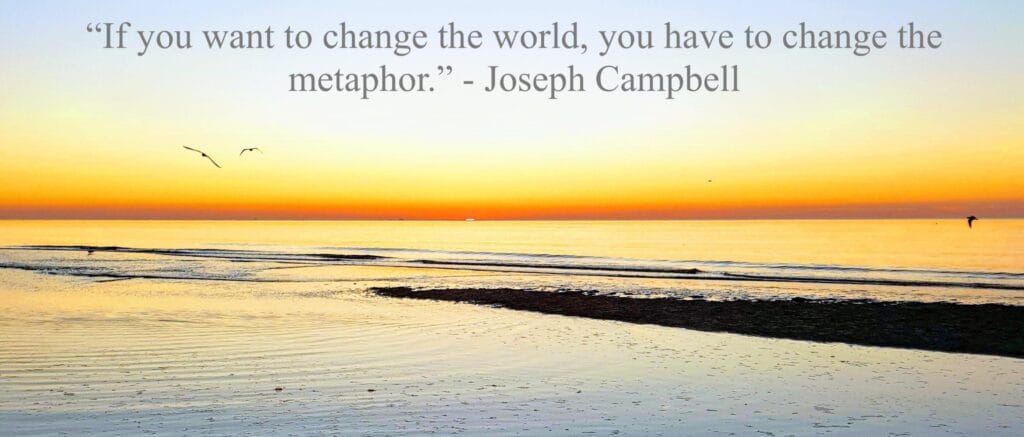
Did you know that, on average, we use six metaphors a minute? Surprised? Me too! They are so embedded into our speech that mostly we are unconscious about them. Research suggests that metaphors change the way we think of a concept on an unconscious level.
In 2011 a study was conducted in which two groups of readers have been presented with two articles describing the same crime. In the first article, the crime was compared to a beast, and in another to a disease. When asked to solve the crime issue, readers of the first article suggested control strategies while the second group came up with diagnostic or treatment strategies. Hence, changing the metaphor changes the way we think.
The power of metaphor
What is a metaphor?
It is a figure of speech that describes an object or action in a way that isn’t literally true but helps explain an idea or make a comparison. The best ones link something which is less understood to something which is more understood. As a result, good metaphors improve our comprehension of the ideas we might not have understood otherwise. Metaphors add colors to the story and make it “sticky.” They enable us to show instead of telling.
Clean Language and Clean questions
Recently I came across a tool that employs the power of metaphors – Clean Language. It is a questioning technique used for discovering, exploring, and working with people’s metaphors. In this questioning method, the questions are called ‘Clean questions’; asking Clean questions means the questioner only uses the words of the answerer embedded into Clean questions without adding their own interpretations. This way, the language of the questioner is ‘clean’ from their own words.
Because the questioner can not add their interpretation into the questions, Clean conversation doesn’t sound like a normal conversation, and frequently it is not even proper English. But this is by design. Clean questions are designed to bring up metaphors. The example that follows in a later section is as intended.
Here are two of the most commonly used Clean questions:
What kind of ‘X’ is that ‘X’?
Is there anything else about ‘X’?
Clean Language helps us to discover metaphors of each other, and with that uncover invisible architectures, create great connection, genuine intimacy, and learning – thus improve comprehension.
Introduction to Clean Language
My introduction to and fascination with Clean Language started with a workshop with Caitlyn Walker. That workshop became an eye-opening experience of observing a multitude of metaphors people create in response to the same question.
The question was, “When you are stuck, it is like what?” No two answers were the same, and no two people equally experienced the state of being stuck.
The outcome of the exercise showed us that each person attaches a different meaning to the concept, and then feels and acts according to that meaning. If we have such different definitions for the same concepts, it’s no wonder that at times we misunderstand each other, and sometimes even clash. The good news is that there is a tool to help us clarify our assumptions and solve our clashes; it’s Clean Language. So stop assuming and start clarifying! When you are stuck, it is like what?
Personal experience with Clean Language
With Clean Language, I have realized that my metaphors are not just the words I use to describe my experiences. They are the views into the models running my life and defining my behavior. Recently, a friend helped me to explore my learning experience with the help of Clean questions. Here is how our Clean conversation went:
(Q) When you are learning, you are like what?
(A) I am like a sponge.
(Q) You are like a sponge, and what kind of sponge is that sponge?
(A) It is a dry, yellow, hourglass-shaped sponge.
(Q) And it is a dry, yellow, hourglass-shaped sponge; is there anything else about that dry?
(A) It absorbs all the knowledge like water.
(Q) And when it absorbs all the knowledge, what happens next?
(A) And then it is full, and water starts to spill over, and it cannot absorb anymore; and then, over time, it dries out…
(Q) What would you like to have happen?
(A) I would like my knowledge to stay with me instead of drying out. And I want to keep learning indefinitely without being limited by a saturated sponge.
It is a moment of profound realization about my way of learning. It is what I experience – I am a lifelong learner, but the knowledge tends to dry out over time, sometimes to the point that I can read the same book as if for the first time. This kind of epiphany makes me want to change my metaphor. Before I was proud of being a sponge-learner, now I see its limitations.
While it is beneficial to explore personal metaphors, there is a lot of value in exploring metaphors of others. For one, you help people to understand themselves better, for another, you get a view into their world and can upgrade and enrich your metaphors.
Discovering and exploring metaphors is just one of the features of Clean Language. Of course, there is more it can do for you.
Applications of Clean Language
There are numerous applications of Clean Language; here are just a few.
- It is a perfect tool for one-on-one coaching and is frequently used for executive coaching. Using Clean questions, the coach helps their clients discover the limiting patterns and beliefs that hold them back, reinforce positive beliefs, make unconscious knowledge conscious.
- Clean Language can be applied in a team setting and used for conflict resolution, shared understanding and focus, building stronger connections. Every team is going through several development stages: forming, storming, norming, and performing. During the storming phase, team members tend to disagree a lot, and conflicts are not uncommon. It is possible to minimize the duration of this stage by equipping the teams with Clean questions as a conflict resolution technique that will help them to get closer to their optimal performance.
- One of my favorite parts of Clean Language, the tool I use very often, is a Clean setup. It is a set of three powerful questions:
A For … to go just as you’d like, it will be like what?
B For [A] to go like that, you’d like to be like what?
C What support or resources do you need?
I use it for various meetings to set up the stage and account for the desires and expectations of each participant. It amazes me that most of the time everything goes just as we’d like, we get precisely the result we want. It keeps consistently delivering the desired outcome.
Starting with Clean Language
With all the marvelous effects that Clean Language has, I want to point out a simple rule of thumb: use only 2-3 consecutive Clean questions around a subject for the sake of the psychological safety of the questioner and the answerer. With Clean questions, you can stir deeper layers of emotions, and it is crucial to be able to support that. So it is advised not to go deeper than ‘level 3’. But do not worry, even if you do not go too deep, there is still lots to explore. It is best to have your first Clean Language exploration with someone experienced.
I hope you are inspired by now to give Clean Language a try.
Changing our world
Now, what would you like to have happen? How would you like to change the world?
We all have aspirations, big and small. We all envision a change. What difference do you want to make? Is it a personal transformation you are looking for, or maybe it is your team that needs improvement? Perhaps, you are dreaming of reshaping your entire organization.
What is the change that you picture?
What metaphor are you going to change?

Many thanks to Joël Grimberg for his great help in creating this article.
I am a specialist at Qxperts. We empower companies to deliver reliable & high-quality software. Any questions? We are here to help! www.qxperts.io





